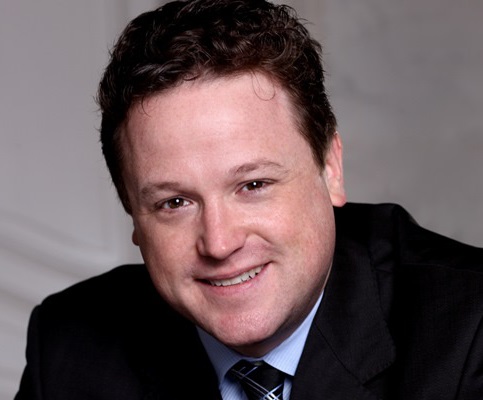Composers, works, events
Announcing the release of Péter Wolf's Wolf-temperiertes Klavier
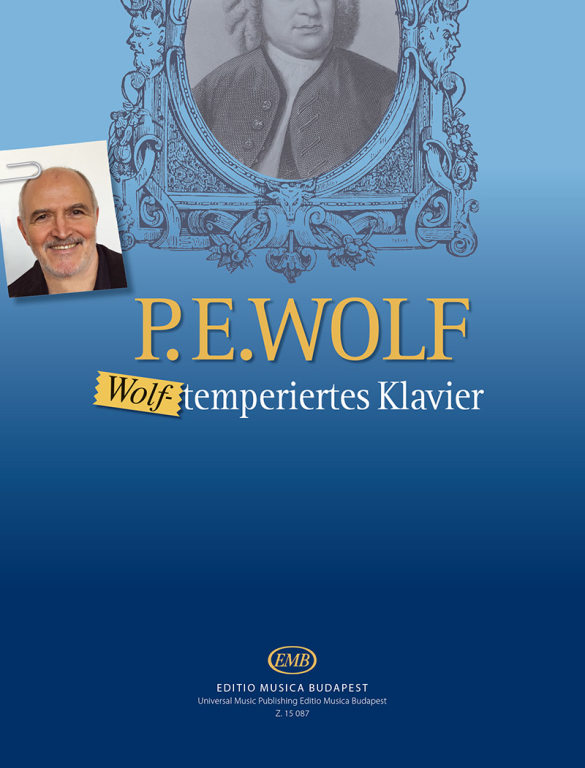 The model for the Wolf-temperiertes Klavier, as the title might suggest, is Johann Sebastian Bach’s keyboard cycle Das Wohltemperirte Clavier. In line with this, Péter Wolf’s collection of 24 piano pieces uses each of the twelve notes of the octave from C to B as home keys (both major and minor) for the movements. It differs from the Bach work in having no fugues, only freely composed praeludia, or as Chopin would have called them, preludes. Péter Wolf is more strongly linked to Chopin and the Romantic and twentieth-century prelude tradition he engendered than directly to Bach, insofar as etude-like virtuoso movements are interspersed with meditative, sentimental pieces in a series that takes us through the world of 24 keys, and the piano technique required is closer to the age of Romanticism than to the Baroque.
The model for the Wolf-temperiertes Klavier, as the title might suggest, is Johann Sebastian Bach’s keyboard cycle Das Wohltemperirte Clavier. In line with this, Péter Wolf’s collection of 24 piano pieces uses each of the twelve notes of the octave from C to B as home keys (both major and minor) for the movements. It differs from the Bach work in having no fugues, only freely composed praeludia, or as Chopin would have called them, preludes. Péter Wolf is more strongly linked to Chopin and the Romantic and twentieth-century prelude tradition he engendered than directly to Bach, insofar as etude-like virtuoso movements are interspersed with meditative, sentimental pieces in a series that takes us through the world of 24 keys, and the piano technique required is closer to the age of Romanticism than to the Baroque.
Listen to: Adagio in E by Péter Wolf, played by József Balog (excerpt)
The score can be ordered here.
Péter Wolf writes what he hears and feels, and this fundamental attitude determines all of his pieces, regardless of what genre he happens to be composing in. And his oeuvre is highly varied. He set out as a pianist, and was admitted to the choral conducting programme at the Budapest Liszt Academy, but instead he studied jazz piano, meanwhile he drifted along with the current of music life, mainly popular music: he played in bands, supplied backing vocals, saved sound recordings, and was an understudy pianist. He composed hit songs, hit film music, made countless arrangements (through the Franz Liszt Chamber Orchestra he came across Isaac Stern, for whom he made arrangements of an entire CD’s worth released on the Sony label in 1998) and wrote much “classical” music too: piano pieces, orchestral works, concertos, and so forth. In 2017 he was awarded the Artisjus Prize for Artist’s Lifework in Popular Music.
His music makes intensive use of almost everything that can be used in a given context, be it from the classical tradition, jazz, or pop music. In this regard we might consider him postmodern, yet there’s something that distinguishes him from the post-war postmoderns. The latter indulged in unbridled cannibalization of anything from the musical past (and their contemporary present), but always did so with ambiguous, guileful irony: the quotation was never in doubt, but its meaning and aesthetic judgement was. Péter Wolf’s post-postmodern music never uses “quotation marks”; this music takes itself seriously in the most classical sense of the word. If he gives a nod to Debussy or Chopin in the 24 piano pieces (just to mention two composers whose figures loom large at several levels), he happily immerses himself in the given musical world, and behind his playing with styles one always senses a deep reverence for the composer referred to. And the movements inspired by popular music, brimming over with emotion, are also free from irony. Péter Wolf firmly believes that music is to be heard, and expresses feelings, and as he is a sincere artist not prepared to comply with external expectations, he follows only his own nose (or ears, or heart); his music too, with untrammelled homeliness, wallows in the musical styles of past centuries and current times.
Péter Wolf’s deft hand not only guides us steadily through a kaleidoscopic cascade of styles, but also vouches for the extraordinarily colourful pianism, and at times dazzling virtuosity, which is at least as important a feature of the Wolf-temperiertes Klavier as the musical ideas themselves. The piano textures of Chopin and Debussy, along with Gershwin’s pianistic ideas, must have been key impulses when the pieces were written, but the true source of inspiration was in all likelihood József Balog, who first played and recorded the works. (Gergely Fazekas)
Kurtág's opera Fin de partie premiered in Teatro alla Scala

Leonardo Cortellazzi (Nagg), Leigh Melrose (Clov) and Frode Olsen (Hamm). Photo: Ruth Walz
On November 15, Teatro alla Scala premiered György Kurtág’s opera Samuel Beckett: Fin de partie, scènes et monologues. In the long-awaited opera Kurtág set Beckett’s drama, which he had seen as a theater performance in 1957 in Paris. The textbook was compiled by the composer, using about half of the playwright’s play, strictly following the process of the drama.
The cast of the world premiere included Frode Olsen (Hamm), Leigh Melrose (Clov), Hilary Summers (Nell) and Leonardo Cortellazzi (Nagg); the orchestra of La Scala was conducted by Markus Stenz, the performance was directed by Pierre Audi.
The performance was created as a joint production with the Dutch National Opera, and further performances will be shown in Amsterdam on March 6, 8, and 10, 2019.
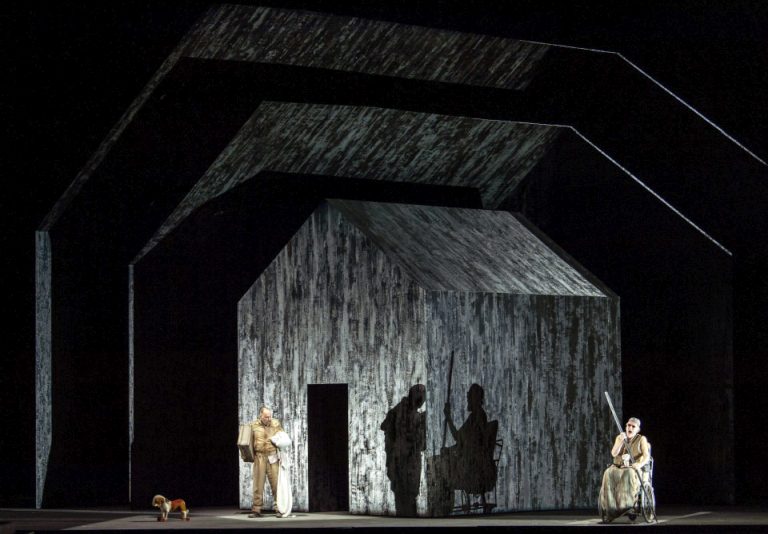
Leigh Melrose (Clov) and Frode Olsen (Hamm). Photo: Ruth Walz
Selection from international press echoes:
Fin de partie is a farewell not just to a life and a marriage, but also to a whole culture. Mr. Kurtág is one of the last who remain of the generation of avant-garde composers that came of age during World War II and in its wake: Boulez, Ligeti, Henze, Stockhausen, Schnittke. Even if the great final scene equivocates — modernism is always on the verge of leaving, it seems to say, yet it is also always here to stay — the opera, drawn from a play that Mr. Kurtág saw in Paris as a young man, is truly goodbye to all that.
(Zachary Wolfe in The New York Times)
The result is a personal tribute to a lifetime’s work. Scrupulous attention to detail, typically exhibited in Kurtág’s miniature compositions, is unflaggingly applied over the opera’s two hours. Myriad orchestral shards colour the French text, which here takes primacy over all. The vocal parts are brilliantly sculpted — refined by Kurtág and the singers over years — and resemble recitation with instrumental support.
(James Imam in Financial Times)
Um Äußerlichkeiten freilich hat Kurtág sich nie geschert, eher lässt einen die Kluft zwischen Plüsch und Partitur doppelt hellhörig werden, und das mag er sich zu Hause in Budapest sogar gewünscht haben (zur Scala-Premiere konnten die Kurtágs nicht kommen). Die "Gefühlswegweiser" seiner Partitur zielen in viele Richtungen: tief ins eigene Œuvre hinein, aber auch zurück zu Monteverdi, zu Debussy und Alban Berg oder gar ins vaudevillehaft Folkloristische (mit Zimbal, Akkordeon und anderen Instrumenten). Eine pergamenten leichte, nie eklektizistische Hand pflegt Kurtág im Umgang mit diesen Farb- und Gedächtnisvaleurs, und so tritt man nach zwei pausenlosen Stunden erfrischt hinaus in die Nacht, ja fast ein bisschen aufgestachelt.
(Christine Lemke-Matwey in Die Zeit)
Kurtágs konzise Musik erweitert Becketts Text in zweifacher Weise: Zum einen bringt sie die Sprache wahrhaft zum Klingen, und zwar in durchweg traditioneller, bisweilen ins Ariose ausgreifender Singweise, dabei aussergewöhnlich subtil dem Sprachfall des französischen Originaltextes nachlauschend. Zum anderen erfasst die Musik aber auch das szenische Geschehen, also die in regelrechte Pantomimen ausufernden Regievorgaben Becketts, die das gross besetzte Orchester in geradezu filmisch-illustrative Klanggesten übersetzt, ohne sie ins Comichafte zu überzeichnen.
(Christian Wildhagen in Neue Zürcher Zeitung)
Kurtág ist ein nüchterner Aphoristiker. Er nimmt zwei Stückchen der alltäglichen Misere und schlägt sie wie Feuersteine aneinander, daraufhin leuchtet ganz kurz ein nie gesehener geheimnisvoller Funke auf, der gleich wieder verlöscht. In „Fin de partie“ reihen sich Hunderte solcher Funken aneinander. Sie sind Kurtágs Kommentare zu Stückverlauf und Charakteren. Sie verleugnen nie ihre Verwandtschaft untereinander, aber Kurtágs Fantasie ist derart unerschöpflich, dass keine Wiederholungen entstehen.
(Reinhard J. Brembeck in Süddeutsche Zeitung)
Kurtág fa Kurtág, non mette nulla di nuovo sul pentagramma, non aggiunge nulla alla sua estetica, non apre squarci interpretativi rivoluzionari rispetto a una carriera fedele a se stessa, alla poetica del frammento, alla rilettura – anche ironica – della forme musicali classiche. Kurtág fa Kurtág. Ma lo fa all’ennesima potenza . E realizza un capolavoro inteso come punto di arrivo, come vertice dove il credo musicale di una vita trova l’espressione più compiuta.
(Pierachille Dolfini in Avvenire)
Kurtág non compone una partitura a commento del soggetto, bensì contrappunta il testo parola per parola, tanto che il messaggio più “puro” lo si coglie solamente nell’Epilogue, con cinquanta battute di sola musica (molti gli accordi misteriosi in pppp) che riassumono il mood di tutta l’opera.
(Luca Chierici in Il Corriere musicale)
Works for clarinet by Gergely Vajda on a new CD
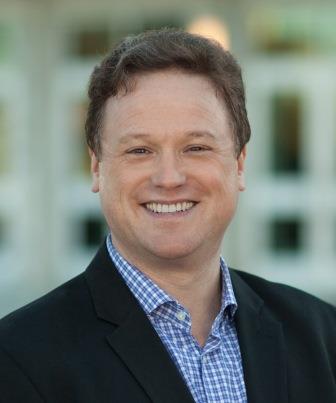 Three compositions by Gergely Vajda, Clarinet Symphony for two clarinets and orchestra, Alice Études for clarinet and string quartet, and Persistent Dreams for solo clarinet, have been recorded on a new CD, released by the Budapest Music Center Records. This offered the occasion to ask Gergely Vajda about his versatility.
Three compositions by Gergely Vajda, Clarinet Symphony for two clarinets and orchestra, Alice Études for clarinet and string quartet, and Persistent Dreams for solo clarinet, have been recorded on a new CD, released by the Budapest Music Center Records. This offered the occasion to ask Gergely Vajda about his versatility.
Clarinettist, composer, conductor – you have all these in your biography. Which is your priority order of these three “c”-s?
I don’t want to offend conductors or instrumentalists but I think creating something from nothing is probably the “king” of all activities, that’s how you can get closest to “Creation” as a human being. If you have the calling for being a composer that should be number one in your life. Performers have to work with the material they get from the composer. I quite often conduct my own works, and then I’m trying to translate my own music into practical terms, to bring it to life.
On your new CD, labelled as Clarinet Symphony, you have works written for clarinet or clarinets and other instruments. Do you feel more at home if you write for your own instrument compared to writing for other instruments?
There is always a point when I remember the physical connections. I don’t compose with my clarinet in hand. Back in the days, twenty-five years ago, when I wrote my very first solo piece, Lightshadow-trembling, I did just that. But these newer pieces were written without, just working in front of the computer screen. The memory of the physical contact, the vibration of the sound, is, however, definitely there, more in case of the clarinet than with other instruments.
Alice Études is a paradoxical piece: On one hand, you find a quotation from Lewis Carroll’s book in every movement, so one would expect it to be program music. On the other hand, it is a series of études for a quintet with clarinet. How would you define the relationship of these two terms?
Études are my meditations based on how I’m reading Alice. The short texts that go with each étude work as inspiration; they all trigger something musical. And that’s how études come in: something is moving, and then you do something with that material. These are études not in the technical sense but on different sounds of the ensemble of a clarinet and a string quartet. As a clarinetist I’ve played a huge classical repertoire and a lot of modern music, so I can say: Schumann didn’t necessarily care about the difference between oboe and clarinet, thus his Fanatasiestücke can be played on both instruments or even on viola. But other composers, like Mozart or Brahms, did really get into the soul of the clarinet. Mozart had an immediate sound in his head, as you can see it also in his operas where clarinet or basset horn goes with certain types and characters. And that’s what I was trying to get in Alice Études: The clarinet is somehow “Alice-y” for me, so I could experiment with the clarinet being Alice in this setup. And because the clarinet can blend with different string combinations and yet there is always a contrast between clarinet and strings, the most interesting for me was how I can mix this sounds in each etude in a different way, at the same time keeping a unity of the composition.
Works by Kurtág, Eötvös and young Hungarian composers in Zürich
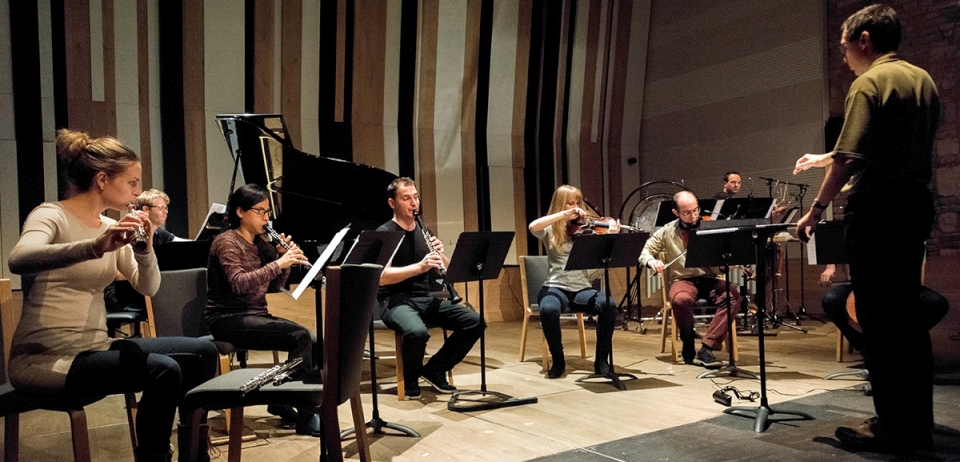
THReNSeMBle with Balázs Horváth (Photo: Andrea Felvégi)
The beginning of Máté Balogh’s, Máté Bella’s, Péter Tornyai’s and Balázs Horváth’s musical career is in many ways tied to Péter Eötvös, who was their driving force in the past few years. It is therefore no surprise that the majority of the programme of the Peter Eötvös Contemporary Music Foundation’s (which Eötvös founded in 2004) concert in Zurich on 26 June consists of works composed between 2010 and 2016 by these young composers. Jam Quartet by Máté Balogh, Chuang Tzu’s Dream by Máté Bella, QuatreQuatuors by Péter Tornyai will be performed for the first time in Switzerland, pikokosmos = millikosmos by Balázs Horváth will be premiered in Zurich. The audience in the Tonhalle will hear the music of three generations. Apart from the Swiss premiere of Eötvös’s da capo (Mit Fragmenten aus W. A. Mozart’s Fragmenten), Kurtág’s Brefs Messages will also be performed. The program is conducted by Eötvös himself, performed by the THReNSeMBle, the ensemble of the Contemporary Music Foundation.
Premieres in Frankfurt – The Works of László Tihanyi and Gergely Vajda
